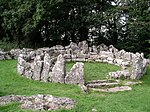Lligwy Burial Chamber
Dolmens in WalesMoelfre, AngleseyPrehistoric sites in AngleseyScheduled monuments in Anglesey

Lligwy Burial Chamber is a Neolithic burial chamber in Lligwy, near the east coast of Anglesey, Wales, United Kingdom. It consists of a circle of upright stones, made into a low chamber by a very large roof slab estimated at 25 tonnes. Excavation in 1909 found the remains of some 15 to 30 people, and pottery suggesting a late Neolithic date. Close to the village of Moelfre, the site is within a few metres of the road, where there is room to leave a single car for short periods.
Excerpt from the Wikipedia article Lligwy Burial Chamber (License: CC BY-SA 3.0, Authors, Images).Lligwy Burial Chamber
A5108,
Geographical coordinates (GPS) Address Nearby Places Show on map
Geographical coordinates (GPS)
| Latitude | Longitude |
|---|---|
| N 53.3499 ° | E -4.2529 ° |
Address
Din Lligwy burial chamber
A5108
LL72 8HD , Moelfre
Wales, United Kingdom
Open on Google Maps











